Conducting regular and objective performance reviews is a great way to keep your team motivated and successful.
Yet, the most recent workplace statistics revealed that managers generally dislike giving feedback to their employees. The same statistics also showed that, ironically, employees want more feedback.
With this discrepancy in mind, this blog post aims to shed new light on the following:
- What performance review actually is,
- Types of performance evaluations,
- Tips for conducting a professional performance review, and
- The importance of performance reviews.
Without further ado, let’s dive into it!

- A performance review is a formal and objective evaluation of an employee’s performance conducted by their superiors or HR.
- A performance review consists of: providing feedback, identifying a professional’s strengths and weaknesses, and stating objectives for the future.
- We can conduct performance reviews in person or virtually.
- It is essential to prepare well for the review, maintain a positive atmosphere during the review and provide a professional with the feedback that will help them improve.
- Regular performance reviews help you increase the organization’s productivity and engagement.
Table of Contents
What is a performance review?
A performance review is a formal and objective evaluation of an employee’s performance conducted by their superiors or HR.
A proper performance review should:
- Provide feedback,
- Identify a professional’s strengths and weaknesses, and
- State the aims and objectives for the future.
Depending on the company’s goals and policies, your superiors can review your:
- Work performance,
- Attitude towards superiors, colleagues, and clients, and
- Aptness to participate in future projects.
In other words, everything you do during your time in the company can be reviewed.
However, that doesn’t mean you should be scared or worried about performance reviews. On the contrary, in the 21st century, a huge emphasis has been placed on understanding the employees’ needs and their patterns of behavior.
Hence, performance reviews are often pleasant talks about what your superiors like about you and what they believe you could do slightly better.
In addition, superiors might use work performance evaluation meetings to discuss further plans and expectations.
Nevertheless, it is not all milk and honey.
If you perform poorly or display a negative attitude in the workplace or during remote work, superiors will point it out and might ask for explanations during your performance review.
In-person performance review vs. virtual performance review
Thanks to collaboration tools such as Pumble, managers and team leaders can conduct performance reviews not only in person but also online.

That leads us to the question: Are there huge differences between traditional (in-person) and virtual performance reviews?
According to Bill Catlette, Partner at Contented Cow Partners (Leadership and Workforce Advisors), virtual performance reviews aren’t that different from traditional ones:

“A virtual review is simply having the same discussion via connective technology. Ostensibly, the only thing that’s different is that the parties aren’t together in the same room.
That said, the same conversational practices and principles that enable other virtual meetings and conversations apply here as well.”
Although we agree that the point of virtual performance reviews and in-person ones is the same, we have to ask: what to do if some professionals aren’t as comfortable online as they are in the brick-and-mortar office?
Bill Catlette explains that a well-mannered and professional approach makes everyone more comfortable:

“If you want the conversation to have good business-related information flow, take time to be human. Think of a physician or other clinician who has used good bedside manners with you. They were prepared, willing to listen, and let you be comfortable with the conversation.”
💡 Pumble Pro Tip
Applying a few virtual meeting etiquette tips will make your virtual performance reviews more comfortable.
To learn more about them, check out the following article:
Types of performance reviews
According to how often you organize performance reviews, there are:
- Monthly reviews,
- Annual reviews, and
- Reviews upon request.
They all have advantages, so let’s learn more about them.
#1 Monthly performance review
Many companies schedule a performance review every month or every 3 or 6 months.
This way, they can track the employees’ progress and check if the recent tasks have been completed properly.
Although scheduling reviews each month keeps your employees constantly motivated, they can produce unnecessary stress and lead to mistakes due to increased pressure.
Hence, if you want to schedule frequent performance reviews, arrange them every 3 or 6 months.
In the meantime, you should:
- Track employees’ progress,
- Provide regular feedback,
- Praise them when needed, and
- Constructively criticize them if necessary.
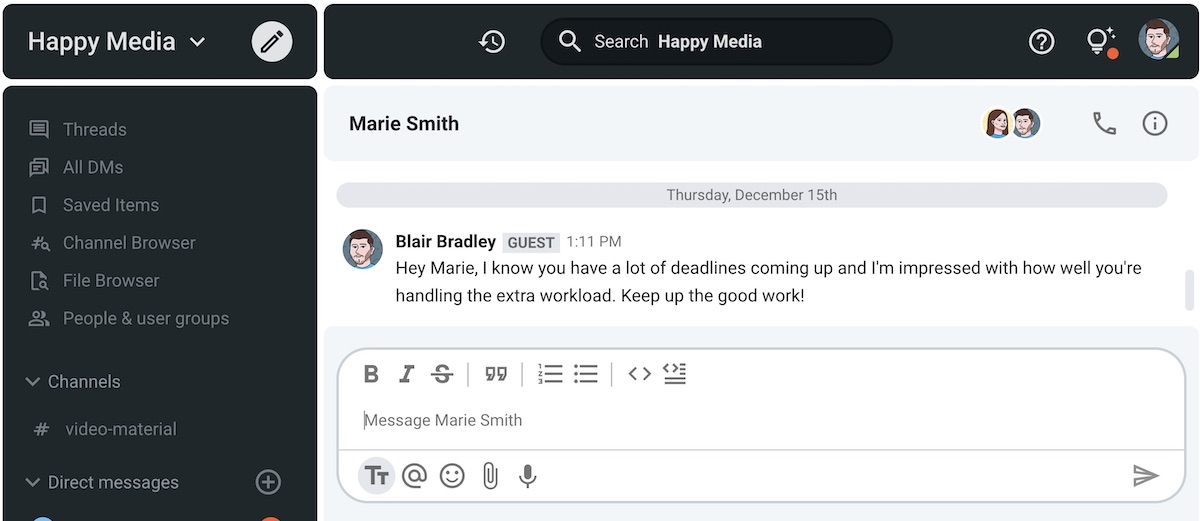
By doing so, your employees will:
- Feel more comfortable,
- Perceive official performance reviews as something pleasant,
- Have enough time to display their qualities, and
- Have more time to work on their shortcomings and eventually improve.
💡 Pumble Pro Tip
As we said above, frequent performance reviews can produce stress, which can affect the overall atmosphere at work.
Since no one wants a toxic atmosphere among employees, we recommend you check out the following article and learn what to do to preserve a positive work environment:
#2 Annual performance review
Annual performance reviews are slowly becoming a thing of the past.
Successful companies such as Microsoft and Deloitte have stopped using this model and adopted a system of more frequent feedback.
However, that doesn’t mean everybody should give up on annual performance reviews.
On the contrary, companies should find a purpose for the annual job performance evaluation and make the whole process of annual reviews more comfortable for the employees.
We recommend scheduling it at the end of the year because it is the perfect time for revising and updating employees’ salaries. Everybody loves bonuses and salary increases, hence, an annual performance review can show you who deserves a raise.
Annual performance reviews provide an all-encompassing image of someone’s performance and progress throughout the year. Furthermore, they show if someone has adopted advice you have given them after monthly reviews or during feedback sessions.
If everything is positive, they can lead to a raise.
But, if an employee’s review doesn’t show signs of effort or improvement, it may be time to introduce measures that reflect their poor performance.
Annual performance reviews were a huge thing in the business world in the 20th century and in the early 2000s.
However, times have changed. It seems professionals don’t like annual performance reviews anymore, and more and more companies foster regular monthly reviews.
#3 Performance review upon request
Performance review upon request is independent of any time frame. In other words, it is scheduled upon request of an employee or superior.
In most cases, it is arranged because an employee wants to apply for a promotion or a raise, and asking for performance evaluations is a part of that process.
Of course, after undergoing the performance review, you shouldn’t ask for another evaluation for at least 6 months afterward unless told otherwise.
On the other hand, if superiors schedule a performance review an employee didn’t expect, that might mean:
- They want to award their performance, or
- If there was a huge and sudden decline in performance, overall performance summary comments might be a warning or wake-up call to an employee.
💡 Pumble Pro Tip
A part of performance reviews may be to have difficult discussions with your employees.
Sharing not-so-affirmative supervisor comments and recommendations might not be the most pleasant thing to do.
Check out the following article to learn more about difficult conversations with employees:
Self-evaluation performance review
A self-evaluation performance review is a unique type of evaluation — it is a way to assess your own performance and self-reflect by pointing out your own strengths and weaknesses.
After completing the self-evaluation form, your superiors can compare your answers with their assessments and give you a clearer picture of your work.
Furthermore, they might see how you perceive your performance — too optimistic or too pessimistic — and use that to boost your morale or help you get a more realistic grasp of your potential.
For example, if an employee thinks of their work as underperforming and superiors tell them it is, in fact, promising or good, that will serve as the perfect motivation for even better work.
On the other hand, if a professional has a bit too high opinion of their work, concrete results and objective analysis of their superiors will show the real picture.
Tips for conducting performance reviews
Considering that a performance review isn’t a “one and done” thing, you should know how to behave before, during, and after it.
Here are 14 tips that will help you while conducting performance reviews:
- Take a performance review seriously.
- Acknowledge the working conditions of each employee.
- Prepare the questions in advance.
- Fine-tune your leadership and coaching skills.
- Have a set of backup collaboration tools ready.
- Use performance evaluation forms.
- Create a positive atmosphere during the employee performance review.
- Foster two-way communication.
- Look for the empath in you.
- Mind your words.
- Talk about the future.
- Send a follow-up message.
- Provide support and guidance to your employees after a performance review.
- Provide regular feedback.
Let’s find out more about them.
Tip #1: Take a performance review seriously
The way you approach performance reviews will determine how successful they will be.
After all, knowing why you are doing this and taking the necessary steps to make it a mutually agreeable and beneficial experience will make it easier for you to follow through.
Catlette supports this point of view, emphasizing that good leaders should set a great example:

“Employers need to decide, from the very top of the organization, whether or not they will be serious about doing the reviews. If senior leaders aren’t willing to prioritize and do them, setting a good example, then all bets are off.”
It’s a good manager’s job to establish reviews as a positive practice in the organization. So, consider the following steps:
- Talk about the performance review process more often, even in informal settings.
- Discuss the performance review concept during weekly and monthly meetings to minimize the negativity surrounding it.
- Prepare your remote employees for future virtual performance reviews by sending out a short guide.
- Organize a performance review mock-up to show your employees what to expect.
Tip #2: Acknowledge the working conditions of each employee
Working in remote, hybrid, and distributed work environments can make it hard to always be aware of the conditions each employee works in.
Some might be juggling toddlers, working from home, and household chores.
Others might be taking care of their elderly family members and working long hours in the evening.
Perhaps some of your remote employees don’t even have a home office, so they go to their friend’s house or a different coffee shop each day to work.
Being aware of your remote employees’ backgrounds and working conditions can help you understand their performance better and make sure to provide them with better chances for success.
Tip #3: Prepare the questions in advance
The benefits of having a set of questions ready before the review are many:
- It makes it easier to maintain the flow of the performance review and helps avoid awkward silence.
- It minimizes the chances of miscommunication in the workplace.
- It shows your genuine interest in your employees’ work and personal lives.
- It can help paint a wider picture of the employees’ working conditions.
- It helps you learn what skills your employees need to work on.
Also, don’t avoid asking tough questions because they can help employees get out of their comfort zone and embrace growth and progress.
Tip #4: Fine-tune your leadership and coaching skills
As executives, everything you say (and how you say it) affects not only your employees but your entire organization.
That’s why you should adapt to every communication situation and know which communication style to employ to reach your employees and get your message across.
Catlette believes that working on their coaching skills can help managers and leaders conduct better remote performance reviews:

“Leaders would do well to work on their leadership coaching skills by adopting and practicing a defined coaching model that will guide them through these types of interactions.
I can recommend a book entitled “The Coach” (Starcevich & Stowell), which offers a very straightforward, well-researched, useful model.”
To be a successful coach to your people, you should never stop improving your coaching skills.
💡 Pumble Pro Tip
Being a successful leader requires constant work.
To make sure you’re going in the right direction, we recommend checking out the following article written specifically to help leaders improve their communication skills:
Tip #5: Have a set of backup collaboration tools ready
If you work remotely and have to organize a virtual performance review, adapting your collaboration tools to the remote working environment is essential.
Besides a secure and reliable video conferencing tool, always have a list of backup tools you can use in case of malfunction.
Consider the following:
- VoIP service: This enables you to conduct calls over the Internet. This is a great solution for hybrid and distributed teams — especially the ones working across several countries and different time zones.
- Business communication tools: Instant business communication apps come in handy for communicating in real-time, particularly if there’s an issue with other collaboration tools you use for conducting remote performance reviews.
- Mobile phone service: This should be your last resort in case of an internet malfunction. Although virtual performance reviews are better off done via a video conferencing tool, it’s smart to have this as another backup option, too.
Tip #6: Use performance evaluation forms
Having a few evaluation forms at hand can’t hurt you.
You can use evaluation forms before conducting the review to collect relevant information and know what to focus on during the review itself.
There are two types of evaluation forms you can use:
- Goals-based evaluation form, and
- Self-evaluation form.
Goals-based evaluation form
Below, you will see a goals-based evaluation form you can use to evaluate the performance of your employee against a set of goals or objectives.
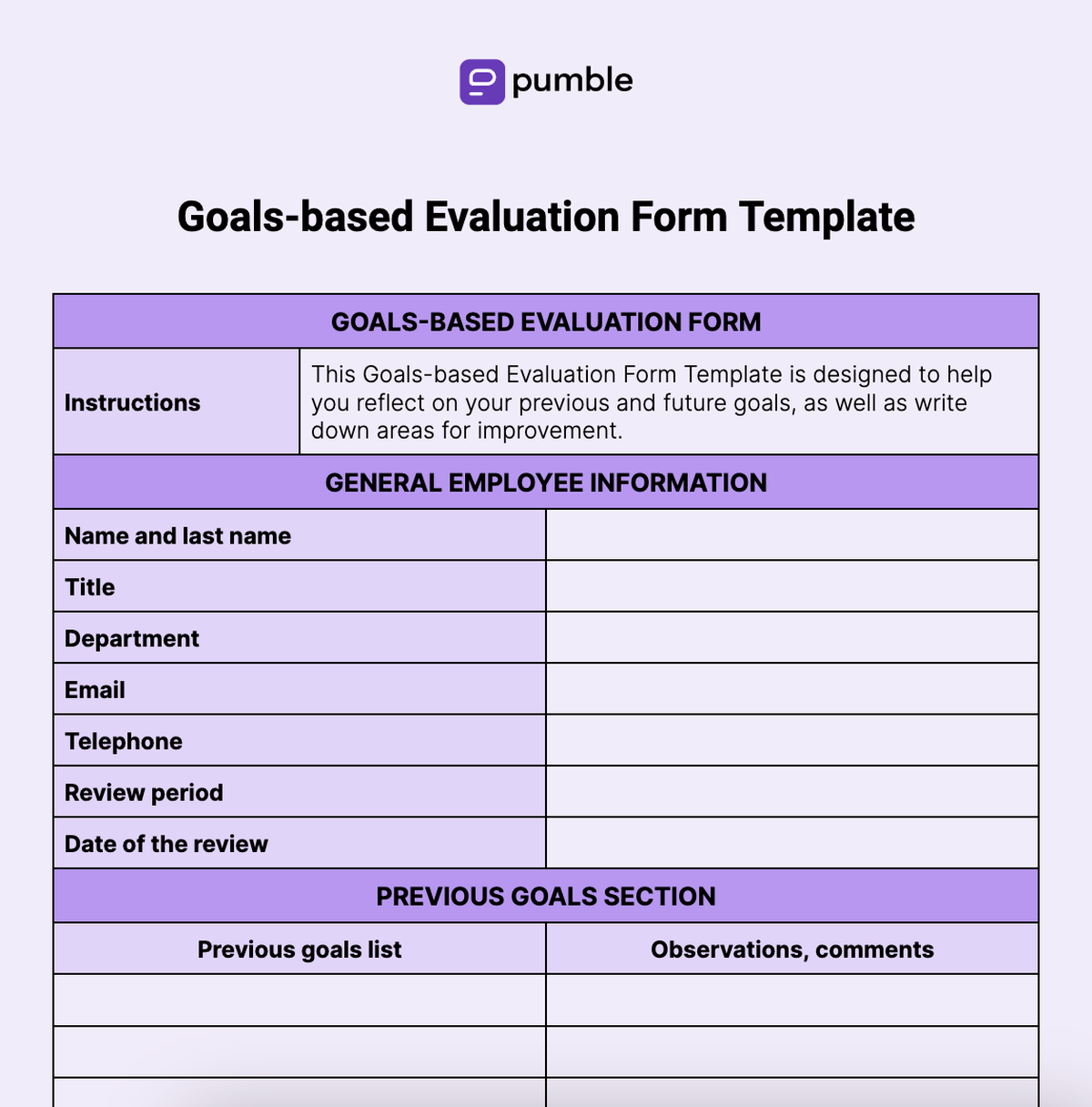
With our template, managers can:
- Write down their observations and comments about previous goals.
- Write down their observations and comments about future goals.
- Add personal notes and comments.
🔽 Download the Goals-based evaluation form template
Self-evaluation form
We have also created a self-evaluation form you can use to encourage critical thinking in your employees and allow them to assess their own work experience.
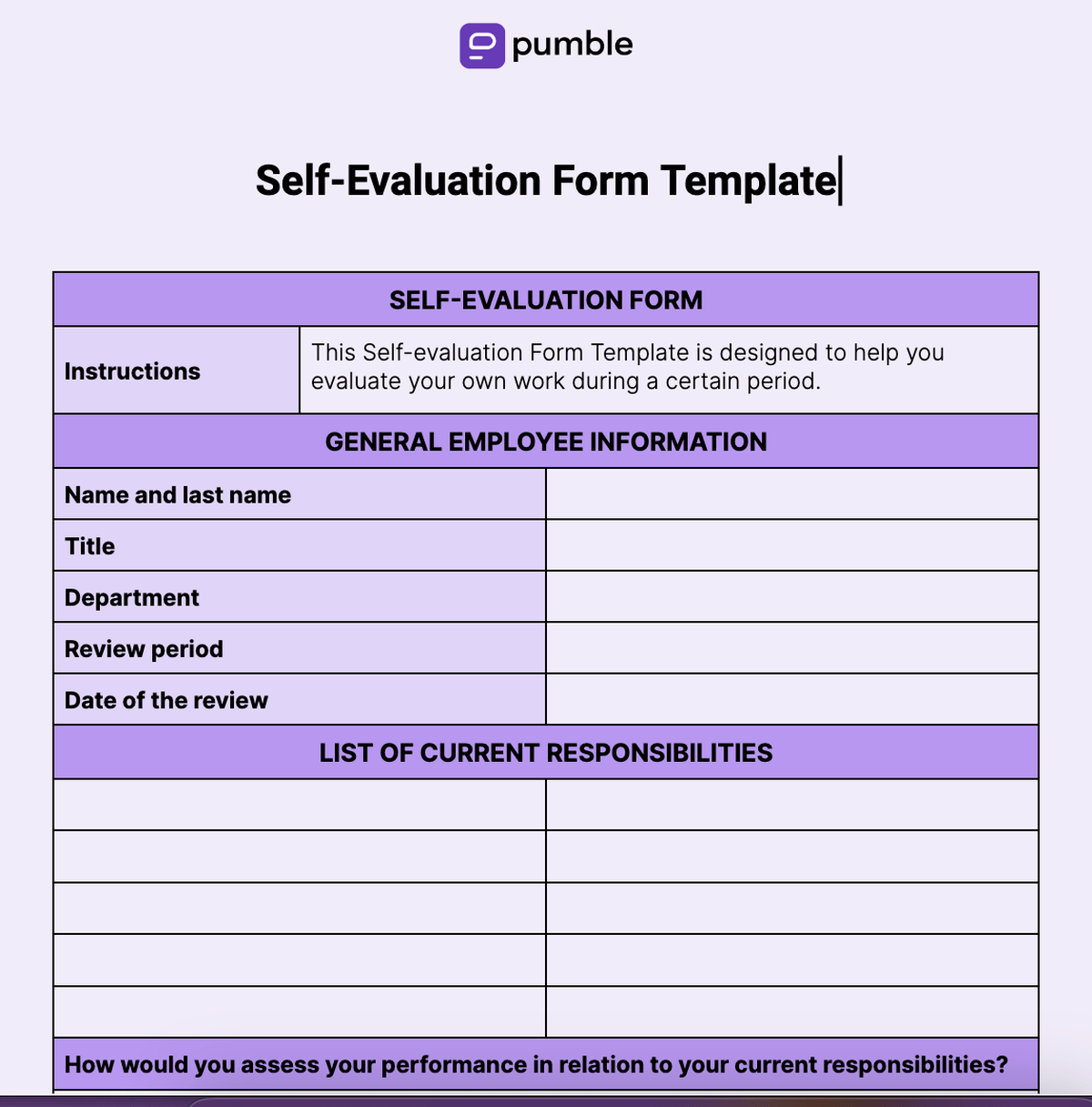
Thanks to a self-evaluation form, employees can:
- Reflect on their current responsibilities.
- Assess their goals and objectives.
- Evaluate how their work aligns with the company’s goals.
🔽 Download the Self-evaluation form template
Tip #7: Create a positive atmosphere during the employee performance review
Employees might approach performance reviews with a “let’s-get-it-over-with” attitude.
But, if you want to turn an employee performance review into an agreeable experience, here’s what you can do:
- Open up with a witty remark or remind them of a funny moment you had together before the review.
- Share some details from your everyday life to help your employee relax and get comfortable.
- Let them see how invested you are in the entire procedure by listening actively and taking notes.
If you appear nervous, your employee will sense it even over the camera during the virtual performance review.
Hence, always remember, that there is no room for nervousness — this should be a mutually enjoyable experience!
Tip #8: Foster two-way communication
A performance review should be seen as an opportunity for a sincere conversation between the manager and the employee.
This is a great way to boost their morale and improve employee engagement.
According to Catlette, creating an environment in which two-way communication comes first can do the trick:

“The performance review process is intended to be an earnest conversation between two adults about the person’s work performance and career path, NOT about filling out another form.
The parties to the conversation need to be:
- Prepared,
- Respectful of one another,
- Willing to listen (really listen), and
- Willing to be coached.”
💡 Pumble Pro Tip
During the conversation with your colleagues and employees, it is crucial to be polite and achieve respectful communication.
One of the things that could be helpful is understanding the concept of diversity in the workplace. To learn more about it, check out the following article:
Tip #9: Look for the empath in you
In Businessolver’s 2023 State of Workplace Empathy study, 68% of CEOs said they are afraid of being less respected if they show empathy in the workplace.
But, it’s high time that leaders and managers took to establishing empathy as another workplace essential, alongside hybrid communication and collaborative leadership.
Managers should also focus on rewriting their internal communication policies to make room for compassion, trust, and humanity in the workplace, too.
So, if you’re performing performance reviews for the right reasons, I’m sure you won’t find it hard to showcase empathy and great listening skills along the way, too.
Let your employees know you’re working in their best interest, and they will be more than happy to return the favor.
Tip #10: Mind your words
Before you start the performance review, it’s wise to remind yourself of what is acceptable to say and what isn’t. Words can hurt, even when unintentional.
And, when we say mind your words, we don’t mean to use corporate buzzwords and empty phrases when addressing serious topics. The point here is to make your employee feel comfortable enough to relax during the review.
Make sure to maintain transparent communication and be specific when giving feedback. Employees genuinely want to know what they are doing well and what they should work on, so make sure to provide them with precise answers.
Here’s a list of words and phrases to avoid when conducting performance reviews:
- Generic words and phrases such as “good” or “bad”, “keep up the good work”, “way to go”, or “nice work”, etc.
- First-person words and phrases like “I”, “me”, “my”, etc.
- Emotive language — i.e., words and phrases that evoke an emotional response.
So, even if you have to talk about their weaknesses and point out mistakes, with the right choice of words you could make it all sound less scary and uncomfortable.
💡 Pumble Pro Tip
Since every workplace requires involvement in many conversations and writing various emails in which you have to mind what you say, we recommend you check out the following articles:
Tip #11: Talk about the future
Even though performance reviews are mostly focused on evaluating previous work, goals, and responsibilities, devoting some time to discussing future plans and goals is important, too.
Here are the ways it can help:
- You can find out more about what your employees have planned for their personal and professional development.
- You can allow your employees to express their thoughts and ideas in a safe space.
- You can help your employees learn more about their own expectations and goals.
- You can get an insight into what you should work on to ensure a more enjoyable experience for your employees.
Tip #12: Send a follow-up message
Insisting on staying in touch in the days and weeks after the review can help your employee stay on track with their goals.
This particularly rings true for performance reviews that end on a negative note.
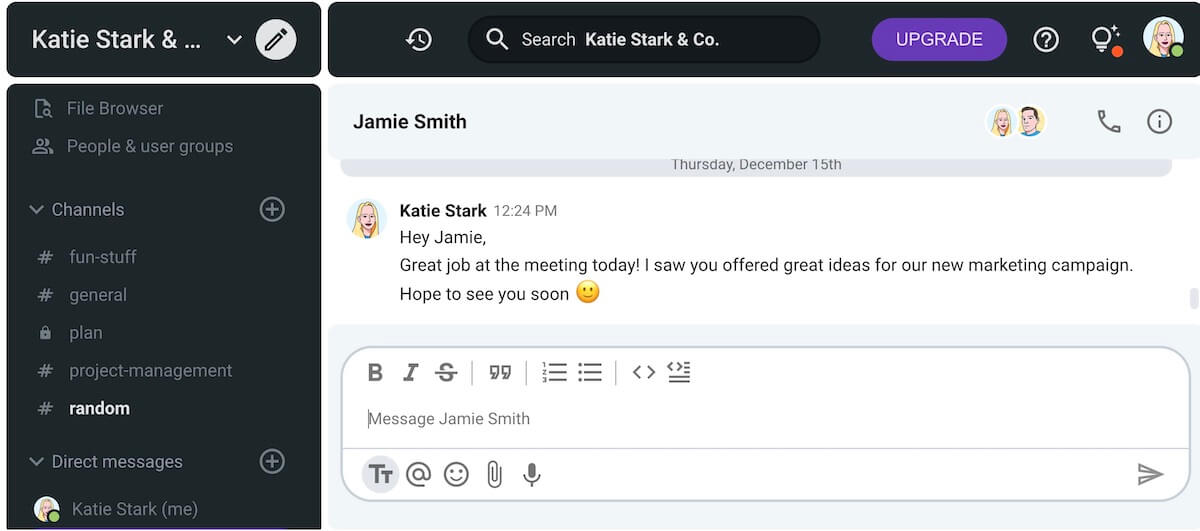
The truth is that the more you communicate with your employees, the easier it will be to support their professional growth and make them an invaluable asset to your organization.
Choosing the right communication channel is essential for making an impact with your follow-up message.
For this purpose, try to steer clear of email communication and use a business communication tool to send a follow-up message instead.
It’s quick, easy, and effective.
Tip #13: Provide support and guidance to your employees after a performance review
According to Gallup’s survey about employee burnout, 76% of employees have experienced burnout at least sometimes.
Bearing in mind that performance reviews often cause increased pressure, which can lead to burnout, it is pivotal to offer support and guidance to your employees during and after the evaluation.
Some of the actions you can take to provide employees with more support at work, help them overcome common workplace issues, and minimize the effects of work-related stress are the following:
- Include wellness practices into company culture — review responsibilities to ensure a manageable workload, and educate managers on understanding burnout and identifying common workplace stressors.
- Understand the employees’ workload, model desirable well-being behaviors, and secure weekend time off.
- Allow employees to have a mental health day off without additional questions.
- Recognize workers’ contributions.
- Allocate time for learning new skills.
As highlighted before, performance reviews can be a source of stress for many employees. But, if you know what areas to address, you are already one step ahead.
Don’t hesitate to reach out with additional support and guidance, your people will appreciate it.
Tip #14: Provide regular feedback
Many agree that maintaining regular communication before and after the employee performance review is key to breaking the stigma around them in the long run.
People and Culture Lead at Inspirant Group, Erin Mohideen, reflects on this:

“I’d like to emphasize that performance reviews are infinitely more effective when performance feedback is ongoing instead of performed on an annual basis.
You are giving feedback to someone because you care about them — so be sure to offer them the attention they deserve during the process.”
Waiting for the next quarter or year to give your employees constructive feedback might be an unwise move.
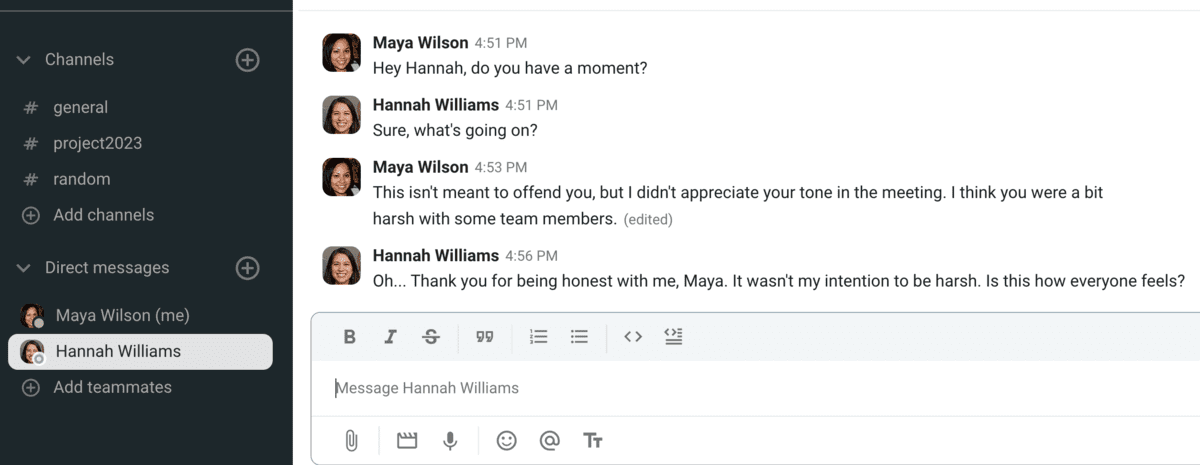
The more you talk about potential improvements and discuss workplace obstacles, the better.
Next time you’re participating in an in-person or remote performance review, both you and your workers might actually enjoy it.
What is the purpose of a performance review?
In all work environments, performance reviews play a paramount role in:
- Promoting effective communication,
- Providing useful feedback about job performance,
- Rewarding top performers,
- Helping struggling employees overcome obstacles and improve performance,
- Giving employees direction and purpose,
- Fostering better workplace relationships,
- Contributing to an employee’s professional development, and
- Increasing employee engagement and overall satisfaction.
But, as we moved to distributed teams and hybrid work arrangements, managers realized that providing employees with regular feedback helps avoid “blindsiding” them at formal evaluation time and reduces the stress that usually surrounds these reviews.
This often includes weekly or monthly one-on-one feedback sessions, sometimes even short emails or constant communication via a business collaboration app.
Catlette concludes that more regular check-ins are generally a good thing:

“One good change that some organizations have made is to have the conversational “check-ins” much more frequently so as to maintain recency and avoid rehashing things that happened eight months ago.”
Conclusion: Don’t wait for the annual performance review to give constructive feedback
Employees want more feedback and they want it more often.
Even if it’s not all “good news”, they would want to know.
It helps them see their weaknesses realistically and look for ways to improve.
In addition, it shows them you value their efforts and are working in their best interest.
There’s no need to wait for the formal review to tell employees what they need to hear — if you do it more often, you’re giving them a chance to improve on the go.
Invest time in communicating constantly with your team and you’ll get to see them stress less about formal performance reviews.
It’s not too late to start now! Good luck!
✉️ Have you ever had a performance review? Do you think it is obsolete in the 21st century? Do you prefer receiving continuous feedback rather than having a performance review every few months?
If so, let us know at blogfeedback@pumble.com and, who knows, maybe we’ll reach out to you and feature your story in a future post. And, if you found this blog post useful, share it with someone you think would also benefit from it.




